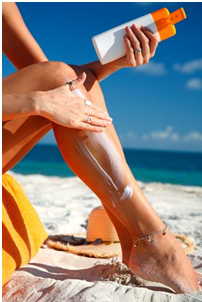 When protecting themselves from the sun, South Africans must not only pay attention to which type of sunscreen they use but also to how much they apply and how often.
When protecting themselves from the sun, South Africans must not only pay attention to which type of sunscreen they use but also to how much they apply and how often.
This is the view of Dr Pete Vincent of the Netcare Travel Clinics and Medicross Family Medical and Dental Centre, Tokai, who is encouraging South Africans to become fully informed about sun protection to avoid developing melanoma and other types of skin cancer. Globally, South Africa ranks as having one of the highest, if not the highest, incidences of malignant melanoma, with people in the Cape being affected worst of all*.
According to the World Health Organization, approximately 66 000 deaths occur globally each year as a result of skin cancer. In a recent survey conducted amongst 1 500 female travellers from the United Kingdom, 22% stated they would not use sunscreen because they believed it was too expensive, that it did not work or that their skin did not burn.
‘What many of these people do not realise is that those who are exposed to the sun intermittently are more likely to develop malignant melanoma, while those who have continuous lifetime exposure are more prone to develop squamous cell carcinoma, which is also a type of skin cancer,’ explains Dr Vincent.
‘Studies indicate that the number of melanoma cases is increasing more rapidly than any other cancer in the UK, United States of America and Australia. While South Africans are generally aware of the dangers of the sun, they do not always know how best to protect themselves and their children from its harsh rays,’ he points out. ‘For example, many people misunderstand or underestimate the importance of the sun protection factor of a sunscreen.’
Vincent explains that the sun protection factor, or SPF as it is more commonly known, is a measurement of how effective a sunscreen is in terms of protection from UVB, the type of ultraviolet radiation that causes the skin to burn.
While UVB rays cause sunburn, they are not the only threat to the skin. UVA rays penetrate deeper and are associated with ageing and skin cancers. UVA protection is measured by a star rating system. It is important to choose a broad-spectrum product that offers good protection against both UVB and UVA rays. According to Dr Vincent the ideal product would have SPF 30 and a four to five star rating.
‘Many people believe that SPF is directly related to how much time one can spend in the sun without burning,’ he says. ‘However, this is not, strictly speaking, the case as SPF is related to the amount and intensity of sun exposure, which varies from time of day and latitude in the world. Therefore a sunscreen that provides proper protection at ten o’clock in the morning may not be sufficient at one o’clock in the afternoon when the sun is higher and exposure is more intense.’
‘Logically, a higher SPF provides more protection and for a greater period of time, but this is not how one should approach the use of sunscreen as there are other factors influencing its efficacy. For example, if you are swimming or engaging in an activity that causes you to sweat, much of the sunscreen will wash or run off your skin. Even if you are using a product that claims to be waterproof, you should reapply after swimming or sweating for an extended period of time.’
Dr Vincent adds that parents should be particularly vigilant about ensuring that their children, who are often more active, have enough sunscreen on at all times. Swimsuits that cover the torso and shoulders can be also helpful in keeping children protected, he says.
‘Another important point to consider is how much sunscreen to apply,’ observes Dr Vincent. ‘There are plenty of people who purchase the right product but do not apply sufficient amounts of it or reapply often enough. In my experience, the majority of people only use half as much as needed.’
Dr Vincent explains that for proper protection you should apply two milligrams of sunscreen to every square centimetre, which in total is approximately two tablespoons overall for a person of average size. This equates to slightly more than half a teaspoon each to the head and face, neck, right arm and left arm. The front torso area, back and left and right legs need slightly more than a teaspoon each. The sunscreen must be applied 20 minutes prior to sun exposure.
‘Proper use of a good sunscreen product is important for avoiding sunburn and skin cancer. However, people should still only expose their skin to as much sun as they would without protection and should certainly avoid the sun between the hours of eleven in the morning and three in the afternoon. It is also important to wear a hat whenever you are exposed to the sun,’ he concludes.
*Melanoma Fact Sheet, South African Melanoma Advisory Board,http://www.melanoma.co.za/D_doccnr_MFS.asp
By Lynne Larsen
Published on 29 October 2012
